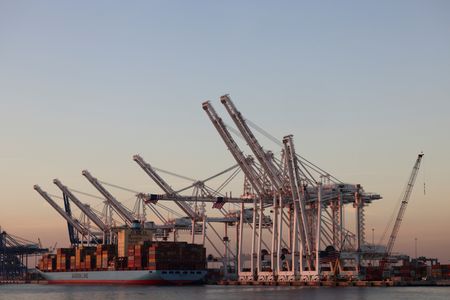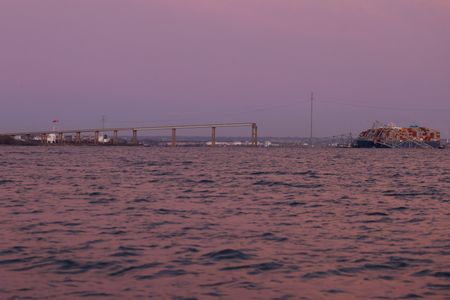LONDON (Reuters) -A major bridge collapsed in the U.S. port of Baltimore in the early hours of Tuesday after being struck by a container ship, plunging cars into the river below.
Traffic was suspended at the port until further notice, Maryland transportation authorities said.
PORT FEATURES
It is the deepest harbor in Maryland’s Chesapeake Bay, closer to the Midwest than other East Coast ports, with five public and 12 private terminals, according to Maryland government website.
It is one of the smallest container ports on the Northeastern seaboard, handling 265,000 containers in the fourth quarter of last year, according to container shipping expert Lars Jensen.
The Port of New York and New Jersey handled around 2 million containers in that same period, and Norfolk Port in Virginia handled 850,000, so the flow of containers to Baltimore can likely be redistributed to bigger ports, Jensen said.
CURRENT STATUS OF CARGO SHIPS INSIDE PORT
More than 40 ships remained inside Baltimore port, including small cargo ships, tug boats and pleasure craft, data from ship tracking and maritime analytics provider MarineTraffic shows.
At least 30 other ships had signaled their destination was Baltimore, the data showed.
IMPORTS
It is the busiest U.S. port for car shipments, handling more than 750,000 vehicles in 2023, according to data from the Maryland Port Administration.
The port handles imports and exports for major automakers including Nissan, Toyota, General Motors, Volvo Car, Jaguar Land Rover and Volkswagen, including luxury models for Audi, Lamborghini and Bentley.
It is also the largest U.S. port by volume for handling farm and construction machinery, as well as agricultural products.
Imports of agricultural products totaled 3 million tonnes last year, including 1.2 million of sugar and salt, as well as gypsum, fertilisers and forest products, according to Ishan Bhanu, lead agricultural commodities analyst at Kpler.
U.S. sugar company ASR Group, which operates a refinery near the center of Baltimore, said it does not expect short-term impacts to its operations.
Other top imports were paper/paperboard and plywood/veneer/particle board, the Maryland authority website shows.
EXPORTS
The Curtis Bay Piers coal terminal is around 3 miles from the highway which ran over the bridge.
During the first nine months of 2023, Baltimore was the second-biggest port for U.S. coal exports, behind Norfolk, Virginia, according to the latest data from the U.S. Energy Information Administration (EIA).
Baltimore exported about 20.3 million short tons of coal, up from 14.3 million short tons during the same period in 2022.
About 13.3 million short tons of exports from Baltimore during the first nine months of 2023 were steam coal and 7.0 million short tons were metallurgical coal
The Baltimore port also exports smaller amounts of other metals and minerals.
Other top export commodities by weight in 2022 were liquefied natural gas (LNG), waste-paper, ferrous scrap, and automobiles/light trucks, according to Maryland government data.
Cove Point liquefied natural gas (LNG) terminal, which is upstream from the bridge, is the nearest LNG terminal.
The terminal’s operator, U.S. energy firm Berkshire Hathaway Energy, said operations were not impacted by the collapse of the bridge, adding it continues to work closely with the U.S. Coast Guard to ensure that the facility is operating safely.
ICIS ship tracking data shows Cove Point typically exports about 500,000 tonnes of LNG per month.
CRUISE SHIPS
It is also a cruise terminal, with Norwegian, Carnival and Royal Caribbean, all using the port for Caribbean, Canadian, and other Atlantic destinations.
In 2023, cruises carrying more than 444,000 passengers departed from the port, the Maryland government website says.
LONDON METAL EXCHANGE WAREHOUSES
In Baltimore warehouses registered with the London Metal Exchange, there are 756 metric tons of nickel, 150 tons of tin and 50 tons of copper, LME data shows.
BUNKER FUEL
Bunker fuel traders said deliveries to the port of Baltimore and Annapolis Anchorage are likely to be affected from the suspension of traffic and ports in Pennsylvania and Virginia could serve as potential bunkering alternatives.
This could affect vessel schedules and may lead to an increase in bunker fuel prices at the alternative ports, depending on how long the port of Baltimore remains inaccessible.
(Reporting by Josephine Mason, Nick Carey, Helen Reid, Jonathan Saul, Nigel Hunt, Marwa Rashad, Scott DiSavino, Shariq Khan and Eric Onstad;Compiled by Josephine Mason and Nina Chestney; Editing by Nick Macfie and Nick Zieminski)

